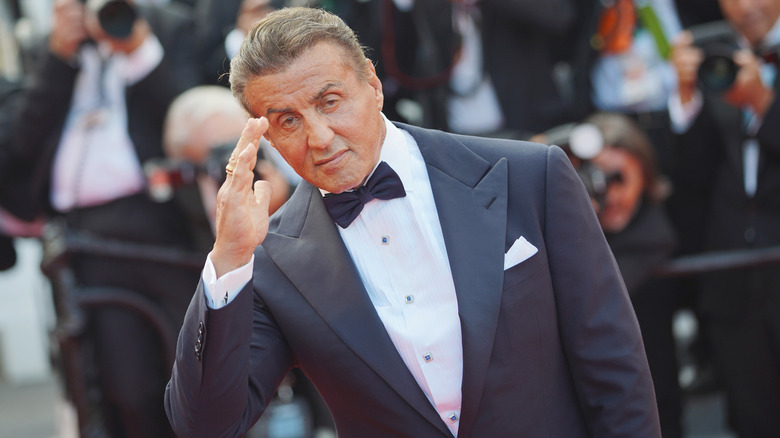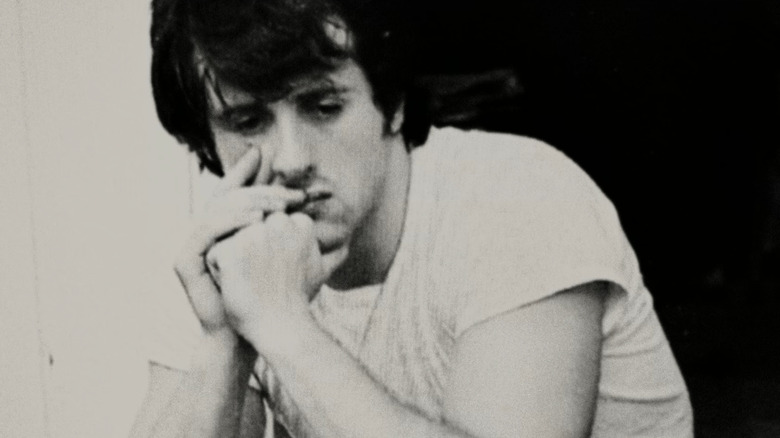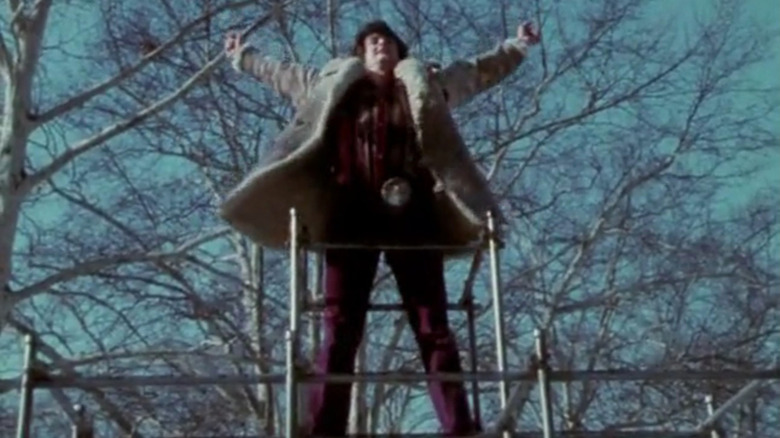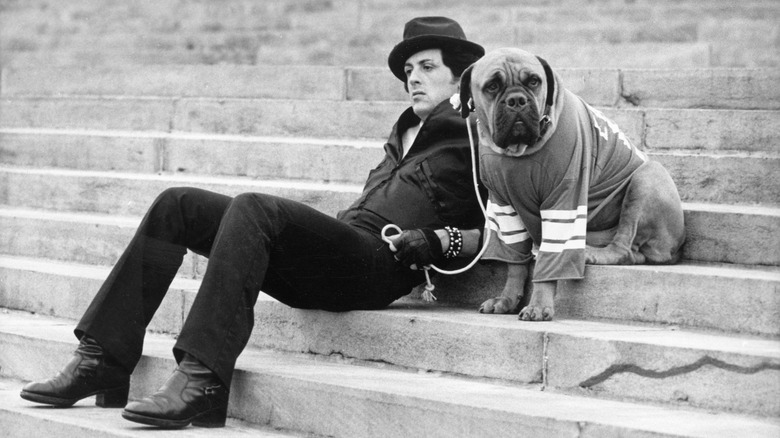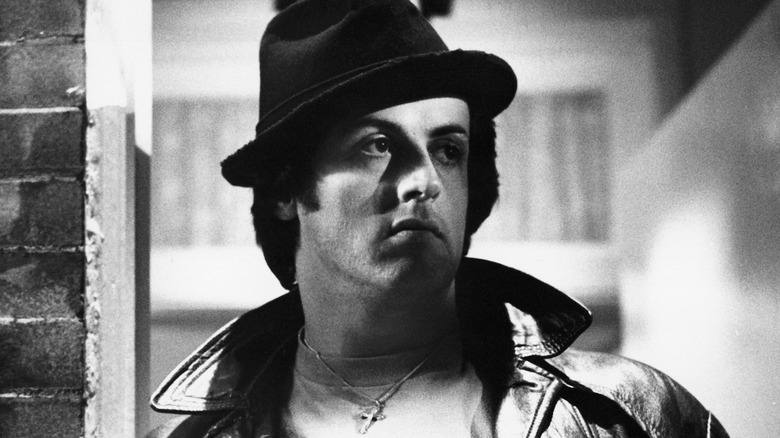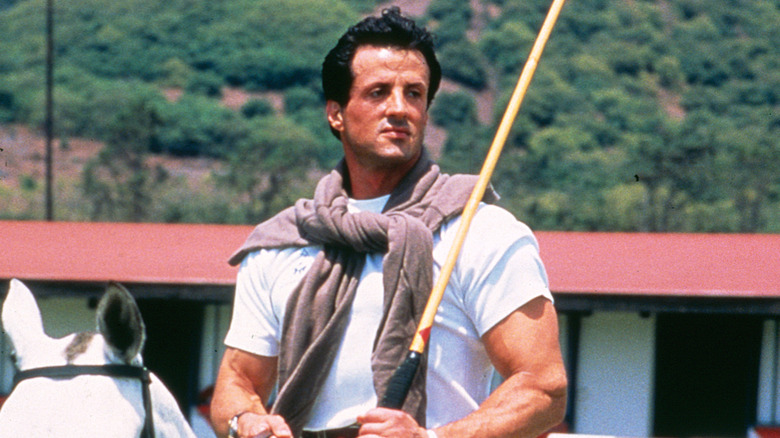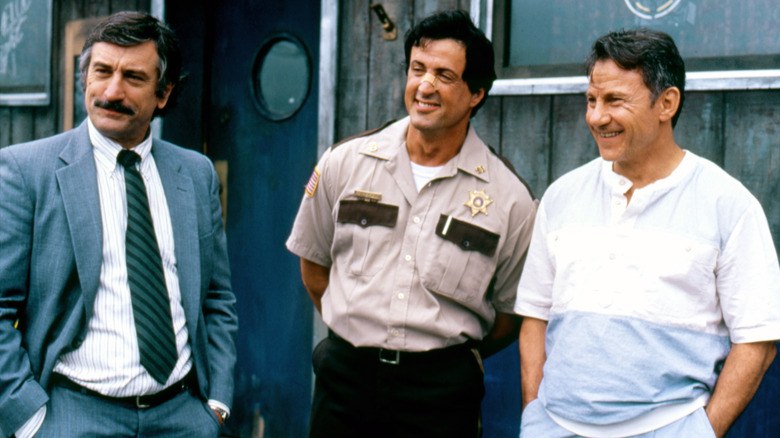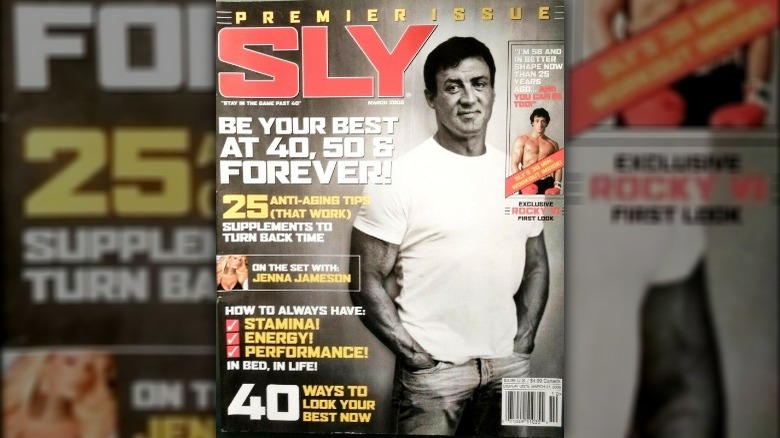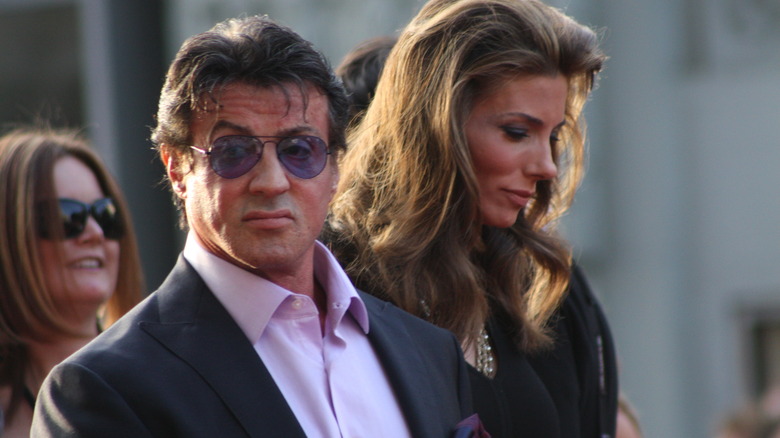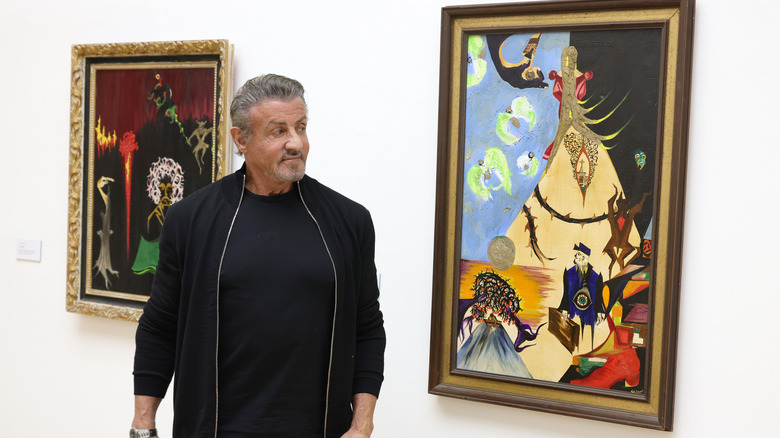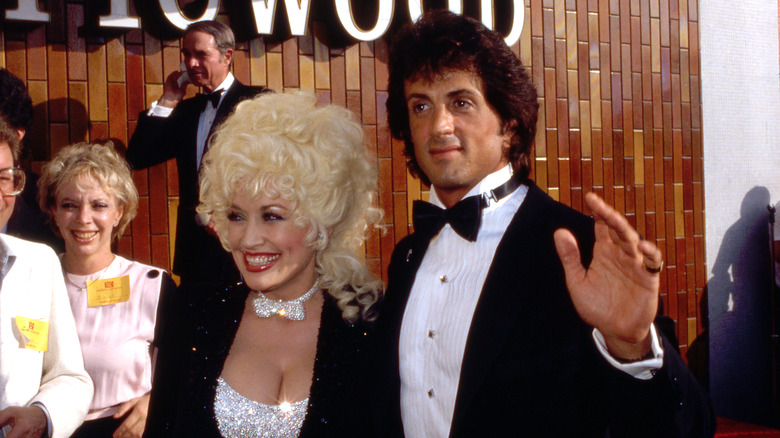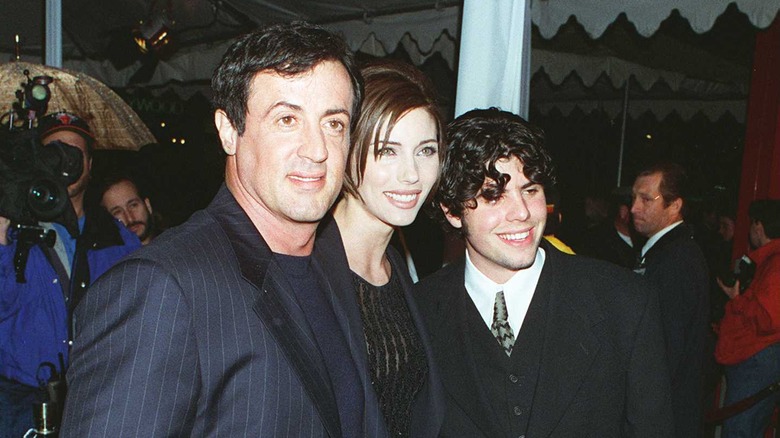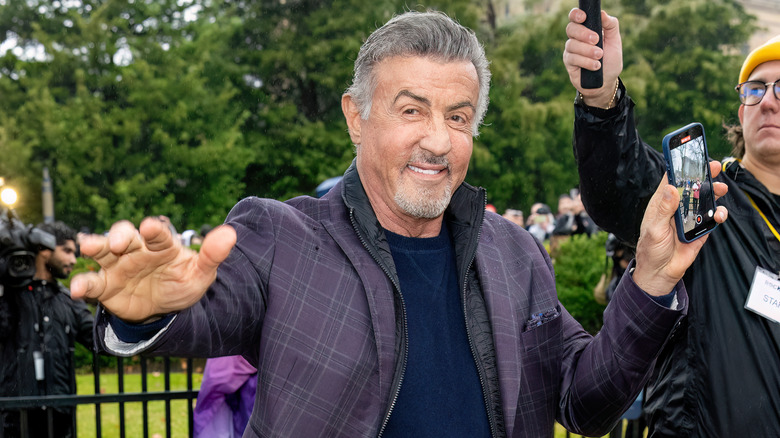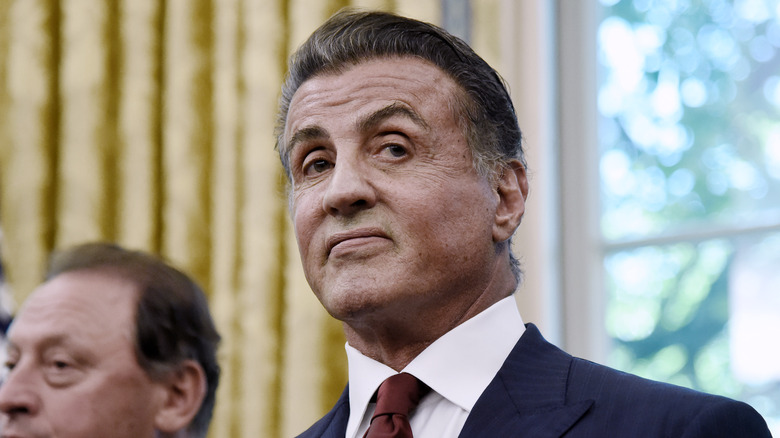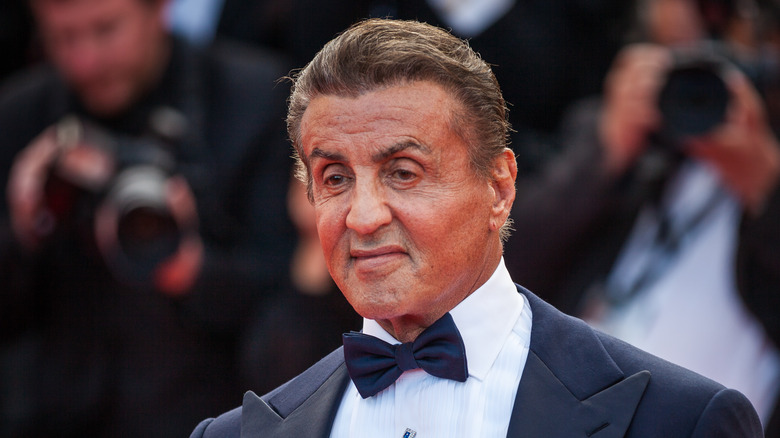16 Little-Known Facts About Sylvester Stallone
Does Sylvester Stallone really need any introduction at this point? The Academy Award-nominated actor and prolific Hollywood icon is one of the most successful artists alive today (per MIT's Pantheon database of memorable people, he's apparently the third most-famous actor in the history of mankind). From "Rocky" and "Rambo" to "Tulsa King" and "The Family Stallone," the Italian-American actor, now in his late 70s, overcame adversity to leave an indelible impact on the entertainment industry, his life rivaling even the greatest underdog tale he ever wrote.
And yet, though Stallone may feel as distinct in our minds as his deep baritone, there's likely much you may not know about the legendary multi-hyphenate artist. Before he invited Paramount+ into his home and then allowed a Netflix documentary, "Sly," to be made about him, his story was largely told through brief interviews and anecdotes. The actor doled out personal revelations seemingly at random. We've gathered some of the most interesting facts about his time in the spotlight (as well as the years just before) to give you a clearer picture of the man in the boxing ring than ever before.
His pre-Rocky career consisted of various menial jobs
Before he was an actor, Sylvester Stallone worked several survival jobs like most aspiring artists — though his pre-"Rocky" career was significantly more varied than others. While studying at the American College of Switzerland, he allegedly held down numerous odd jobs to pay for tuition, room, and board. Though he wasn't at his "Rocky IV" peak of physical fitness yet, he used his broad build to work as a bouncer on campus. When he wasn't dealing with drunk college kids, Sly is said to have sold hamburgers and taught gym classes.
This episodic career didn't slow to a steady pace when he finally moved to New York City. While trying to break into the entertainment industry, he had various jobs far from the limelight, including cleaning out the lion cages at the Central Park Zoo. This particular job apparently involved withstanding the large felines' 15-foot urine streams, with the actor telling Playboy magazine in 1978 that he quit after just a month as a result. "'This is marvelous, Sylvester,'" he recalled thinking to himself at the time. "'You've gotten to the point in your life where you're now making $1.12 an hour to get pissed on by a lion.'"
Arguably the closest he came to a career in cinema before his big break was when he worked as an usher at Walter Reade Cinemas, though his time there was short-lived. Not satisfied with the pay he received helping customers, he began scalping tickets on the side for extra cash — which ultimately resulted in him mistakenly offering his services to the theater owner. He was fired.
He starred in a strange softcore porn film to avoid committing a crime
Perhaps Sylvester Stallone's most infamous pre-"Rocky" gig was his starring role in the softcore adult film "The Party at Kitty and Stud's," in which he played the titular "Stud" hosting a drugged-fuel orgy (while there's plenty of nudity on display throughout, none of the intercourse depicted is any more real than his sex scene in "Demolition Man"). While there's absolutely nothing shameful about acting in an adult film or otherwise performing sex work, Stallone wasn't able to enter the industry with much agency.
A year into his move to New York City, the actor found himself sleeping in a bus station and struggling to stay alive. Stallone reflected on this period of his life while recording a commentary track for "Rocky" in 2001, in which he described it as being at "the very end of [his] rope." It was during this period of extreme poverty that Stallone sold his dog.
Though it may not have been the ideal gig for the young Stallone at the time, he's stated that his only financial alternative was to turn to crime. Getting $200 for two days' worth of work was preferable to robbing a stranger or spending another night in a bus station, narrowly avoiding arrest — and aside from an opportunistic post-"Rocky" re-release of the film by the production company (tastefully retitled "Italian Stallion"), its had a relatively negligible impact on his career.
He fought hard to keep himself in the ring for Rocky
By the mid-1970s, the writing was on the wall for Sylvester Stallone. In an era when average Italian-American actors were getting passed over for pretty much everything but mob flicks, Stallone couldn't even land a role as one of Michael Corleone's (Al Pacino) 300-plus nameless Italian wedding guests in "The Godfather." No one was going to give him a career — so he'd have to make one for himself.
With no prospects coming from writers, Stallone resolved to craft his own opportunity. In 1975, he penned the screenplay for "Rocky" in just four days, after which he gave it to none other than "Happy Days" star Henry Winkler. Having remained friends after their time in "The Lords of Flatbush," Winkler helped get the script in front of network executives at ABC — and they ultimately chose to produce it as a TV film. But when the network wanted to remove Stallone from the project, he urged Winkler to withdraw the script from contention. Fortunately, another Winkler read "Rocky."
Producers Irwin Winkler and Robert Chartoff loved the "Rocky" screenplay so much that they offered Stallone $360,000 for the rights to turn it into a major motion picture. Once again, however, Stallone faced pushback from studio execs when he insisted he'd play the title role. Eventually, all parties agreed to allow Stallone to act for union wage, which gave him $80 a day for acting. In the end, his deal resulted in about $35,000 for the entire shoot — screenplay included.
He could've been Superman
A big-budget, big-screen version of "Superman" went into production in 1976-'77, just after Stallone became a huge star with "Rocky." He was in consideration to play the Man of Steel, but director Richard Donner ultimately didn't think he was right for the part, as well as wanting to go with a relatively unknown actor (the role ended up going to Christopher Reeve, and the rest was history). But it was the rejection of another major player that may have really sealed Stallone's dismissal: his intense, sensitive-tough guy performance in "Rocky" earned him favorable comparisons to Marlon Brando. Brando had been cast in "Superman" as Jor-El — and he reportedly refused to be in a movie with someone who might upstage him.
As a major movie star for more than 40 years, Stallone has almost landed plenty of roles. On a 2014 appearance on "The Tonight Show," Stallone revealed that he auditioned to play Han Solo in "Star Wars." He could instantly tell that director George Lucas wasn't interested and bowed out, telling filmmakers that he "would look like crap in spandex, leotards, and a ray gun." In 2006, Stallone told Ain't It Cool News of "several films I missed out on and wished I'd done." Those films: the 1978 Vietnam War homefront drama "Coming Home" (which earned an Oscar for Jon Voight), the 1985 Amish country police mystery "Witness" (which landed Harrison Ford an Oscar nomination), and the dark and twisted 1995 thriller "Se7en."
He was once on track to be a top polo player
Despite his rather gritty break into acting, Sylvester Stallone came from affluent beginnings, and he once played a sport far less bloody than boxing. On the polo field, a middle school-aged Sly shined on horseback, immediately taking to it. By age 13, just two years after his first match, Stallone was a nationally ranked polo player competing in the top echelons of his age division. In the Netflix documentary "Sly," his brother Frank Stallone Jr. states confidently that the future "Rocky" star was primed for a promising athletic career as a professional polo player — that is, until his interest was cut short by a traumatic experience involving his late father, Frank Stallone Sr.
According to Sylvester Stallone, Frank Sr. spent the better part of a polo match berating his son from the stands loudly for what he perceived to be poor treatment of the horse on Sylvester's part. Supposedly unsatisfied with Sylvester's response, Frank Sr. then stormed the field in the middle of the game to essentially assault his son. "I pulled the horse up to get ready for another throw, and [Frank] comes out of the stands, grabs me by the throat, throws me on the ground, takes the horse, and walks off the field," said the younger Stallone. "I laid there and I went, 'I never want to see a horse again in my whole life.'" He eventually played in an exhibition match alongside his father when he was 40 — but that too was a contentious affair.
He physically transformed his body for Cop Land -- but not in the way you'd expect
Especially after "Rocky IV," Sylvester Stallone was the poster boy for the Hollywood bod. The outrageous muscles he and actors like Arnold Schwarzenegger packed on for the action classics of the '70s and '80s became genre-defining attributes, and they were arguably precursors for the dramatic body-building transformations of Marvel actors like Chris Pratt and Kumail Nanjiani. For the 1997 crime drama "Cop Land," Stallone wanted to get as big as possible — but muscles were the last thing he was after.
Following a string of terrible roles (including in the film "Stop! Or My Mom Will Shoot," which he was famously fooled into taking by rival action star Schwarzenegger), Stallone had finally landed a promising dramatic character as a New Jersey sheriff fighting corruption within his own district, playing opposite Ray Liotta and Robert De Niro. This wasn't Lt. Cobra, but an aging police officer far from the action and even further from Stallone's usual type.
Never one to shy away from a challenge, he set out to gain as much fatty weight as possible by eating French toast, cheesecake, and pancakes. Though he wanted to cover up his abs and lose the definition in his arms, director James Mangold especially wanted Stallone's face to look noticeably different. In total, he gained somewhere between 30 and 50 pounds. His performance wound up being one of the best-reviewed of Stallone's career.
He had his own short-lived health magazine
If there's one thing more audacious than turning down hundreds of thousands of dollars not to have the lead role in your own screenplay, it's launching a print magazine in the mid-2000s — this is especially true if your most recent film credit happens to be "Spy-Kids 3D: Game Over." Yet that's just what Sylvester Stallone did when he began circulating his health and lifestyle magazine "SLY." Beneath Stallone's name in giant red block letters on the cover, the publication's tagline read, "Stay in the game past 40."
The "premiere issue" (which will run you a modest $29.95 on resale sites like eBay) featured an exclusive first look at the then-upcoming "Rocky VI," Stallone's personal 30-minute workout routine, and an interview with pornstar Jenna Jameson from the set of one of her adult films (along with the boilerplate listicles one would find in any magazine targeted at men in the midst of a mid-life crisis). Future issues would see SLY collaborate with Brooke Burke, Sharon Stone, and Pamela Anderson.
A few months after it went into circulation, however, SLY magazine was hit with a $1 million copyright infringement lawsuit from SlyMagazine.com, an online publication targeted at young women looking for fashion advice from just about anyone but the Italian Stallion (the lawsuit didn't make it very far, as a judge ultimately determined that it was on the consumer if they thought it was Stallone telling them which shoes looked both professional and stylish). Sadly, however, it was soon divorced dads who would be left without their own fashion and lifestyle guru, as SLY magazine disappeared after just a few issues.
He sold a line of pudding -- then got sued again for stealing the recipe
If you thought SLY magazine was Sylvester Stallone's most bizarre and fiscally, legally, and logically dubious business move, please allow us to introduce you to "Stallone High-Protein Pudding" (stop laughing, this is a PG website). As the actor explained in an interview with Larry King that can only be described as tonally delirious, Stallone's protein pudding was exactly what it said on the tin — pudding with 20 grams of protein and very little fat or carbs.
The entire conversation between Stallone and King is simply mystifying, especially for the product itself, which hadn't been introduced to the viewing consumer beyond the nutrition facts. Instead, the two men lightly bicker about how many grams of this or that are actually in the can, what supplements one could take with them (a lot of words like "thermogenics" and "biotanical" get thrown around here), and whether or not his current supplement stack would mix well with Viagra. "You'll be jousting up and down the street," boasted Stallone, before continuing to pump up his protein pudding (we told you not to laugh).
Once again, Johnny Law proved to be the bane of Stallone's entrepreneurial endeavors. In 2010, he and a former business partner were sued by a nutrition scientist over allegations that they had stolen the recipe for the pudding. The subsequent legal battle was tumultuous and reportedly resulted in an out-of-court settlement. The product, meanwhile, has since been discontinued for unknown reasons.
He's a visual artist
Long before Rocky Balboa was the subject of a multimillion-dollar sports drama franchise, Sylvester Stallone brought him to life through a medium he knew far better than film at the time. "Painting is the purest of all arts," he said at the opening of an exhibition of his work in Germany. "And it's not like film, where 500 people are responsible for the final product. Here it's one man who has to take the fame, the ridicule or the criticism."
Since he was a young man, Stallone has consistently expressed himself on canvases to a prolific extent, drawing inspiration from a range of artists including Picasso and Mark Rothko. Among his body of work is a self-portrait, which made waves back in 2009 when it was sold for tens of thousands of dollars. Critics derided the piece rather harshly, and it has continued to earn him ridicule years later. This piece is arguably a poor example of Stallone's capabilities as a painter. The flatly abstract 1977 portrait lacks the fiery use of color and the deft use of space of his other work, like his portraits of Edgar Allen Poe and Hercules. The self-portrait especially pales in comparison to his first image of Rocky, carved — not painted — into canvas using a screwdriver. "If he looked interesting visually, then I think that he would translate through to literature and then cinema," he told DW.com. "I know it sounds ambitious, but that was the genesis of Rocky."
The Razzies love him
The Golden Raspberry Awards were established in 1981 to "honor" the worst films of the year. At the ceremony, held in Los Angeles the night before the Academy Awards, recipients of the "Razzie" receive a gold spray-painted raspberry trophy. No one has received more vitriol from the Razzie Awards than Stallone — he's been nominated more than 30 times and won on 10 occasions. Among these "victories" are Worst Actor trophies for "Rhinestone," "Rambo III," and "Tango & Cash"; Worst Screenplay for "Rambo: First Blood Part II"; and Worst Screen Couple (with Sharon Stone) for "The Specialist." The Razzies even created special awards just to trash Stallone a little more, including Worst Actor of the Decade (covering his 1980s output) and Worst Actor of the Century in 2000. After Stallone was nominated for Worst Actor of the Century, Razzies founder John Wilson told The Hollywood Reporter that he received "a voicemail that sounded like" Stallone, complaining. "For legal reasons we can't say it was him — but his point was 'my movies make money, stop picking on me.'
However, after his Academy Award-nominated turn in 2015's "Rocky" spinoff "Creed," the organization showed him a little love, honoring him with the Redeemer Award, for moving "from all-time Razzie champ to award contender." Four years later, he was back to earning the disdain of the Razzies, racking up Worst Screenplay, Worst Actor, and Worst Screen Combo (alongside "his impotent rage") for the franchise-ending "Rambo: Last Blood."
The death of his son, Sage, was initially misreported
In 2012, Sylvester Stallone's eldest son, Sage, tragically died at the age of 36. Though he had kept relatively far from the spotlight compared to his larger-than-life father, "Rocky" fans felt something of a connection to Sage following his featured role as Rocky Balboa's son in the series' fifth installment. When news of his passing first broke, speculation ran expectedly rampant until an official statement was made. Early reporters offered their theories — including one that Stallone vehemently denied.
Sage Stallone's death was initially reported by tabloid news sites The New York Post and TMZ, the latter of which claimed — based only on unnamed sources — that the cause of death had been a drug overdose. That same month People magazine interviewed Sage's friends, who anonymously claimed that he had been addicted to Vicodin around the time of his death. Sylvester Stallone finally had to beg members of the press to respect his privacy and his son's memory by not making baseless speculations about Sage's life.
Shortly afterward, the Los Angeles County Coroner's office pointed out that Sage's stocky frame was far from consistent with those addicted to pills, while his mother stated that what pain medication was found in his system (and leaked to tabloids) was due to him having five teeth pulled two weeks beforehand. Though some outlets including TMZ attempted to spin this development by alleging Sage was merely dealing drugs, it eventually came out that his cause of death was a common form of heart disease.
If you or anyone you know needs help with addiction issues, help is available. Visit the Substance Abuse and Mental Health Services Administration website or contact SAMHSA's National Helpline at 1-800-662-HELP (4357).
Despite rumors stating otherwise, his iconic visage is not the result of Bell's palsy
It's become something close to a Hollywood urban legend at this point that Sylvester Stallone's iconic facial composition and his unique speech patterns were a side effect of a protracted case of acute peripheral facial palsy — commonly referred to as Bell's palsy — that set in when he was a newborn. However, this condition is not usually permanent by any means, resolving itself in as little as two weeks without treatment, though some people can have lasting effects.
Stallone eventually revealed the real cause of his partial facial paralysis in the documentary "The Making of 'Rocky vs. Drago,'" which chronicles how he, Irwin Winkler, and actor Dolph Lundgren created the rivalry at the heart of "Rocky IV." In the doc, he tells filmmaker and longtime friend John Herzfeld that when he was born, his family was financially struggling, and as a consequence, his birth took place in a charity hospital ward. A doctor there allegedly attempted to remove Stallone from his mother's womb using forceps to circumvent a dangerously complicated birthing process. Both he and his mother survived, but the doctor accidentally severed a nerve that left part of his face paralyzed.
Stallone suffered bullying throughout his childhood as a result of this paralysis and later experienced difficulty acting due to his naturally slurred speech. This ultimately inspired him to improve the parts of his body he could control by bodybuilding.
Sylvester Stallone almost landed a high-ranking job in the Trump administration
Shortly after Republican Donald Trump won the 2016 presidential election, he started to staff the many soon-to-be-vacant spots in his incoming administration. In December 2016, The Daily Mail reported that President-Elect Trump was considering Sylvester Stallone, who had supported Republican candidate John McCain's 2008 presidential campaign and had reportedly publicly called the new chief executive "larger than life," for the position of chairman of National Endowment for the Arts. The NEA is a federal-level agency that provides funds and grants to artists and creative undertakings, and Stallone taking the job wouldn't have been without precedent, as another actor, Jane Alexander, once chaired the organization.
According to Deadline, Stallone was at least informally considered for the job, which carried a $146 million budget. In a statement, he said he was "flattered" by the idea, but wasn't interested, expressing a desire to serve his country in some other way. As he put it, "I believe I could be more effective by bringing national attention to returning military personnel in an effort to find gainful employment, suitable housing, and financial assistance."
Sylvester Stallone's role in The Suicide Squad was written for him at the last minute
The 2021 movie "The Suicide Squad" represents many surprising Hollywood comebacks. It's a second take for "Suicide Squad," a film that just five years earlier earned $750 million, is written and directed by James Gunn, getting a second chance after a Hollywood rejection over old and unseemly tweets, and it features one-time long-ago action movie superstar and Academy Award-winner Sylvester Stallone in a rare supporting role that doesn't even show his famous face. In the film about a team-up of villains in the Batman universe, Stallone voices King Shark, a walking, talking land shark that eats people but who's still a likable guy.
At a promotional event (via TheWrap), Gunn admitted that he wrote the role with Stallone in mind, but said he was "afraid" that the actor's distinctive voice wouldn't be a good fit. "So we had a huge audition process with tons of voice actors," Gunn said, revealing that three different voice actors each recorded virtually the entire movie, but none of them felt right. In the end, Gunn approached Stallone. When he described King Shark as a "big, kinda chubby, human-eating shark," Gunn tweeted that Stallone laughed and signed on, quipping, "Anything for you, brother."
The Family Stallone was made during a terrible period of his marriage
Aside from his work in the Paramount+ crime-drama "Tulsa King," Sylvester Stallone's largest TV project is the reality series "The Family Stallone." The program chronicles the day-to-day lives of him, his wife Jennifer Flavin, and their three daughters. While "The Family Stallone" follows in the footsteps of other glossy family shows like "Keeping Up with the Kardashians" in terms of sanitizing its subjects, Stallone's show is uniquely awkward in how it dances around the very public family problems he was dealing with.
The series was apparently filmed immediately after Stallone wrapped principal photography on "Tulsa King," with the first episode featuring reactions from his family as they prepare to welcome him home. Despite Flavin's somewhat winsome reception, she ominously posted weeks beforehand on Instagram that her daughters were her only priority and that "nothing else matters."
Nine days later, she filed for divorce, and Stallone proceeded to get his tattoos of her covered up with various animals (which would've surely made for the most dramatic tattoo-related reality TV sequence since Kris Jenner had a truly majestic meltdown after Rob Kardashian got a massive tattoo of his father on his forearm). A month later, the divorce was called off — again, their reconciliation was completely ignored by the TV series supposedly documenting Stallone's "ultimate home movie."
Is Sylvester Stallone starting to slow down?
In its first weekend of theatrical release in August 2021 "The Suicide Squad" earned $35.1 million and became the No. 1 film at the North American box office. That achievement was also monumental in the career of Sylvester Stallone, who voices King Shark. Since his career began in earnest in the mid-1970s, according to Deadline, Stallone has starred in 46 theatrically released films, of which nearly half — 20 in all — topped the weekly box office charts. Not only does the actor have a lot of hits, he's been consistent with them, and for a very long time. In fact, Stallone has appeared in a No. 1 movie in six straight decades, from the 1970s, through to the 2020s, a Hollywood scarcity.
Stallone has established a long resume of films, if not a legacy, and as he approaches his late 70s, he's starting to look back on what he's done — and what, if anything, is left. "At my age, I look at every film like maybe it's my last bullet. I try to aim it in the right direction and work hard on it," he told Esquire Middle East. "It wasn't always like that. In the '80s I felt like I was going to live forever."
